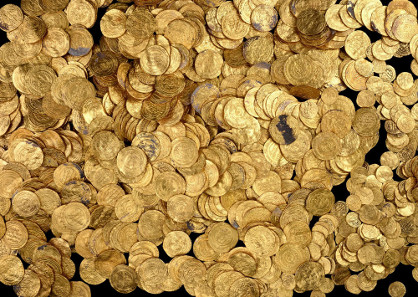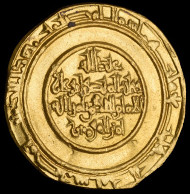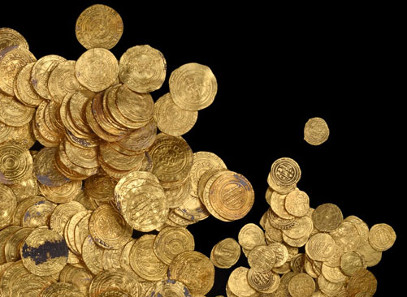November 26, 2015 – In February 2015, divers off the coast of Caesarea spotted by chance a group of gold coins lying on the seabed.
The treasure consists of nearly 2,600 gold coins. Photographed by Clara Amit, Israel Antiquities Authority. With permission of the Israel Antiquities Authority.
They immediately alerted marine archaeologists of the Israel Antiquities Authority, who conducted a salvage excavation at the site and recovered more than 2,600 coins of pure (24 karat) gold weighing a total of 7.5 kg.
Abu ‘Ali al-Mansur al-Hakim bi-Amr Allah. (AH 386-411/996-1021 CE), gold dinar minted in Cairo, AH 403/ 1012 CE. Photographed by Clara Amit, Israel Antiquities Authority. With permission of the Israel Antiquities Authority.
The coins date from the mid-9th to the early 11th century CE. They were minted by the Fatimid caliphs of Egypt, who ruled over a vast empire stretching from North Africa in the west to Syria and Yemen in the east. The wealth of the Fatimid caliphs and the opulence of their court were legendary, making Cairo one of the most important economic and cultural centers in the Islamic world. At the zenith of its power, the Fatimid Empire stood at the center of global trading network that reached as far east as China and India, and as far west as the Iberian caliphate of Cordoba and the Byzantine Empire.
Dinars and quarter dinars from the Caesarea treasure. Photographed by Clara Amit, Israel Antiquities Authority. With permission of the Israel Antiquities Authority.
The treasure contains two types of coins: gold dinars weighing around 4 g each and gold quarter-dinars weighing 1 g. These were the most common coins of the period, as silver coins were rare and bronze coins were not used at all. The treasure might have been tax-money collected by a government official returning to Cairo, the capital of the Caliphate, when his ship was wrecked. Alternately, it could have been payment, perhaps meant for soldiers stationed in the Fatimid garrison of Caesarea, that was sent out from the capital but which never reached its destination.
The treasure was probably worth a century of wages at its time. Photographed by Clara Amit, Israel Antiquities Authority. With permission of the Israel Antiquities Authority.
Eleventh-century documents from the Cairo Genizah indicate that the salary of a craftsman at that time was approximately two gold dinars per month. Based on the number of coins found so far, the treasure would have been the equivalent of 1,200 months’ salary – a century of wages – or five and a half million shekels based on the minimum wage in Israel today.
The Caesarea gold treasure is on loan from the Israel Antiquities Authority, in honor of the Museum’s 50th Anniversary, and is displayed at the entrance to the Samuel and Saidye Bronfman Archaeology Wing until 22 December 2015.
The display is a joint project of the Israel Antiquities Authority the Caesarea Edmond Benjamin de Rothschild Corporation and the Israel Museum, Jerusalem.
This is the official website of the Israel Museum.










